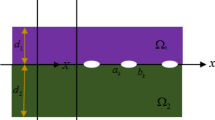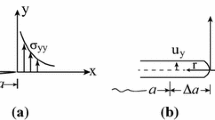Abstract
Interfacial crack growth is inherently mixed mode in nature and mode-mixity must be defined clearly in order to characterize it. Mode and mode strain energy release rates for an interfacial crack in bimaterial system were analytically derived by the virtual crack closure technique. It is shown that the energy release rate for mode and mode do not converge due to the presence of violent oscillatory near tip behavior. However, the total energy release rate is well-defined.
Similar content being viewed by others
References
England, A. H., 1965, “A Crack between Dissimilar Medica” ASME J. Appl. Mech., Vol. 32, pp. 400–402.
Erdogan, F., 1963, “Stress Distribution in a Nonhomogeneous Elastic Plane with Cracks,” ASME J. Appl. Mech., Vol. 30, pp. 232–236.
Erdogan, F., 1965, “Stress Distribution in Bonded Dissimilar Materials with Cracks,” ASME J. Appl. Mech., Vol 32, pp 403–410.
Hamoush, S. A. and Ahmad, S. H., 1989, “Mode I and Mode II Stress Intensity Factors for Interfacial Cracks in Bi-Material Media,” Eng. Fract. Mech., Vol. 33, No. 3, pp. 421–427.
Hong, C. C. and Stern, M., 1978, “The Computation of Stress Intensity Factors in Dissimilar Materials,” J. Elasticity, Vol. 8, pp. 21–34.
Irwin, G.R., 1957, “Analysis of Stresses and Strains Near the End of a Crack Traversing a Plate,” J. Appl. Mech., Vol. 24, pp. 361–364.
Malyshev, B. M. and Salganik, R. L., 1965, “The Strength of Adhesive Joints Using Theory of Cracks,” Int. J. Fract. Mech., Vol. 1, pp. 114–128.
Matos, P.P.L., McMeeking, R. M., Charalambides, P.G. and Drory, M. D., 1989, “A Method for Calculating Stress Intensities in Bimaterial Fracture,” Int. J. Fract., Vol. 40, pp. 235–254.
Raju, I.S., Crews Jr, J. H. and Aminpour, M. A., 1988, “Convergence of Strain Energy Release Rate Components for Edge-Delaminated Composite Laminates,” Eng. Fract. Mech., Vol. 30, No. 3, pp. 383–396.
Rice, J.R. and Sih, G. C., 1965, “Plane Problems of Cracks in Dissimilar Media,” ASME J. Appl. Mech., Vol.32, pp. 418–423.
Smelser, R.E., 1979, “Evaluation of Stress Intensity Factors for Bimaterial Bodies using Numerical Crack Flank Displacement Data,” Int. J. Fract., Vol. 15, pp. 135–143.
Sun, C. T. and Jih, C. J., 1987, “On Strain Energy Release Rates for Interfacial Cracks in Bi-Material Media,” Eng. Fract. Mech., Vol 28, No. 1, pp. 13–20.
Sun, C. T. and Manoharan, M. G., 1989, “Strain Energy Release Rates of an Interfacial Crack between Two Orthotropic Solids,” J. Comp. Matls., Vol. 23, pp. 461–478.
Wang, S.S. and Yau, J.F., 1982, “Interface Cracks in Adhesively Bonded Lap-Shear Joints,” Int. J. Fract., Vol. 19, pp. 295–309.
Williams, M. L., 1959, “The Stresses around a Fault or Crack in Dissimilar Media,” Bulletin of the Seimological Society of America, Vol. 49, pp. 199–204.
Yau, J.F. and Wang S. S., 1984, “An Analysis of Interface Cracks between Dissimilar Isotropic Materials using Conservation Integrals in Elasticity,” Eng. Fract. Mech., Vol. 20, pp. 423–432.
Author information
Authors and Affiliations
Rights and permissions
About this article
Cite this article
Chai, YS., Choi, BS. The components of energy release rate for interfacial cracks. KSME Journal 5, 104–107 (1991). https://doi.org/10.1007/BF02953608
Received:
Issue Date:
DOI: https://doi.org/10.1007/BF02953608




